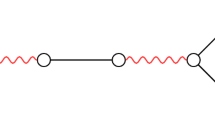Abstract
The cover polynomial and its geometric version introduced by Chung & Graham and D’Antona & Munarini, respectively, are two-variate graph polynomials for directed graphs. They count the (weighted) number of ways to cover a graph with disjoint directed cycles and paths, can be thought of as interpolations between determinant and permanent, and are proposed as directed analogues of the Tutte polynomial.
Jaeger, Vertigan, and Welsh showed that the Tutte polynomial is #P-hard to evaluate at all but a few special points and curves. It turns out that the same holds for the cover polynomials: We prove that, in almost the whole plane, the problem of evaluating the cover polynomial and its geometric version is #P-hard under polynomial time Turing reductions, while only three points in the cover polynomial and two points in the geometric cover polynomial are easy. We also study the complexity of approximately evaluating the geometric cover polynomial. Under the reasonable complexity assumptions RP ≠ NP and RFP ≠ #P, we give a succinct characterization of a large class of points at which approximating the geometric cover polynomial within any polynomial factor is not possible.
Similar content being viewed by others
References
Artur Andrzejak (1998) An algorithm for the Tutte polynomials of graphs of bounded treewidth. Discrete Mathematics 190(1–3): 39–54
Ilia Averbouch , Benny Godlin & Johann A. Makowsky (2008). A Most General Edge Elimination Polynomial. In Graph-Theoretic Concepts in Computer Science, 34th International Workshop, WG 2008, Durham, UK, June 30 – July 2, 2008. Revised Papers, volume 5344 of Lecture Notes in Computer Science, 31–42.
Andreas Björklund, Thore Husfeldt, Petteri Kaski & Mikko Koivisto (2008). Computing the Tutte polynomial in vertex-exponential time.
Markus Bläser, Holger Dell & Johann A. Makowsky (2008). Complexity of the Bollobás-Riordan Polynomial. In 3rd International Computer Science Symposium in Russia (CSR), 86–98.
Markus Bläser & Christian Hoffmann (2008). On the Complexity of the Interlace Polynomial. In 25th International Symposium on Theoretical Aspects of Computer Science (STACS 2008), Susanne Albers & Pascal Weil, editors, 97–108. Internationales Begegnungs- und Forschungszentrum für Informatik (IBFI), Schloss Dagstuhl, Germany, Dagstuhl, Germany. http://drops.dagstuhl.de/opus/volltexte/2008/1337
Markus Bläser & Christian Hoffmann (2009). Fast Evaluation of Interlace Polynomials on Graphs of Bounded Treewidth. In Algorithms-ESA 2009, 17th Annual European Symposium, volume 5757 of Lecture Notes in Computer Science, 623–634. Springer.
Lenore Blum, Felipe Cucker, Michael Shub & Steve Smale (1998). Complexity and real computation. Springer-Verlag New York, Inc., Secaucus, NJ, USA. ISBN 0-387-98281-7.
Béla Bollobás, Oliver Riordan (1999) A Tutte Polynomial for Coloured Graphs. Combinatorics, Probability and Computing 8(1–2): 45–93
Andrei Bulatov, Martin Grohe (2005) The complexity of partition functions. Theoretical Computer Science 348(2): 148–186
Timothy Y. Chow (1996). A Short Proof of the Rook Reciprocity Theorem. Electr. J. Comb. 3(1).
Fan R.K. Chung, Ronald L. Graham (1995) On the cover polynomial of a digraph. Journal of Combinatorial Theory Series B 65(2): 273–290
Bruno Courcelle, Johann A. Makowsky, Udi Rotics (2001) On the fixed parameter complexity of graph enumeration problems definable in monadic second-order logic. Discrete Applied Mathematics 108(1–2): 23–52
Ottavio M. D’Antona, Emanuele Munarini (2000) The cycle-path indicator polynomial of a digraph. Adv. Appl. Math. 25(1): 41–56
Martin Dyer, Alan Frieze & Mark Jerrum (2002). On Counting Independent Sets in Sparse Graphs. SICOMP: SIAM Journal on Computing 31.
Martin E. Dyer, Alan M. Frieze, Mark Jerrum (1998) Approximately Counting Hamilton Paths and Cycles in Dense Graphs. SIAM Journal on Computing 27(5): 1262–1272
Martin E. Dyer, Leslie Ann Goldberg & Mike Paterson (2006). On Counting Homomorphisms to Directed Acyclic Graphs. In Proceedings of the 33rd International Colloquium on Automata, Languages and Programming, ICALP 2006, volume 4051 of Lecture Notes in Computer Science, 38–49. Springer.
Michael R. Garey & David S. Johnson (1979). Computers and Intractability. Freeman, San Francisco.
Omer Giménez, Marc Noy (2006) On the Complexity of Computing the Tutte Polynomial of Bicircular Matroids. Combinatorics, Probability and Computing 15(3): 385–395
Leslie Ann Goldberg, Mark Jerrum (2008) Inapproximability of the Tutte polynomial. Inform. Comput. 206(7): 908–929
Christian Hoffmann (2010) A Most General Edge Elimination Polynomial - Thickening of Edges. Fundam. Inform. 98(4): 373–378
François Jaeger, Dirk L. Vertigan, Dominic J.A. Welsh (1990) On the computational complexity of the Jones and Tutte polynomials. Mathematical Proceedings of the Cambridge Philosophical Society 108(1): 35–53
Mark Jerrum, Alistair Sinclair (1989) Approximate Counting, Uniform Generation and Rapidly Mixing Markov Chains. Information and Computation 82(1): 93–133
Mark Jerrum & Alistair Sinclair (1997). The Markov Chain Monte Carlo Method: An Approach to Approximate Counting and Integration. In Approximation Algorithms for NP-hard Problems, D. Hochbaum, editor. PWS Publishing Company.
Mark Jerrum, Alistair Sinclair & Eric Vigoda (2004). A Polynomial-Time Approximation Algorithm for the Permanent of a Matrix with Nonnegative Entries. JACM: Journal of the ACM 51.
Nathan Linial (1986) Hard enumeration problems in geometry and combinatorics. SIAM J. Algebraic Discrete Methods 7(2): 331–335
Martin Lotz, Johann A. Makowsky (2004) On the algebraic complexity of some families of coloured Tutte polynomials. Advances in Applied Mathematics 32(1): 327–349
Johann A. Makowsky (2008) From a zoo to a zoology: Towards a general theory of graph polynomials. Theory of Computing Systems 43(3): 542–562
Noble S.D. (1998) Evaluating the Tutte Polynomial for Graphs of Bounded Tree-Width. Combinatorics, Probability & Computing 7(3): 307–321
Christos M. Papadimitriou (1994) Computational Complexity. Addison-Wesley, Reading, Massachusetts
Leslie G. Valiant (1979) The complexity of computing the permanent. Theoretical Computer Science 8(2): 189–201
Leslie G. Valiant, Vijay V. Vazirani (1986) NP is as easy as detecting unique solutions. Theoretical Computer Science 47(1): 85–93
Author information
Authors and Affiliations
Corresponding author
Rights and permissions
About this article
Cite this article
Bläser, M., Dell, H. & Fouz, M. Complexity and Approximability of the Cover Polynomial. comput. complex. 21, 359–419 (2012). https://doi.org/10.1007/s00037-011-0018-0
Received:
Published:
Issue Date:
DOI: https://doi.org/10.1007/s00037-011-0018-0




